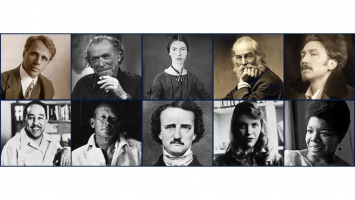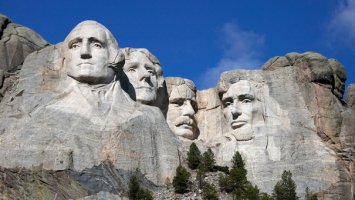Top 10 Facts about the United States Military Academy at West Point
The United States Military Academy at West Point (also known as West Point, USMA) is a university that trains students to become officers in the United States ... read more...Army. The mission of the United States Military Academy at West Point is to inspire, educate, and train the Cadet Corps so that each graduate is a qualified leader who upholds American ideals of duty, honor, and patriotism and is ready for a distinguished and successful career as an officer in the United States Army. Below is a list of the Facts about the United States Military Academy at West Point that Toplist would like to introduce to readers.
-
The oldest active Army base in the United States, West Point, New York, was originally held by the Continental Army on January 27, 1778. Tadeusz Kosciuszko, a Polish engineer, and war hero directed the building of the garrison defenses for this army between 1778 and 1780. The governor of New York and General George Clinton, however, did not support Kosciuszko's proposal for a tiny fortress system because they thought that a battery along the river to disturb ships was preferable.
Rufus Putnam, Washington's chief engineer, thereby oversaw the development of a large fortification on a hill that rose 500 feet (150 m) above sea level that commanded the West Point plain. It was given the name Fort Putnam by General Alexander McDougall. Hence, the Continental Army was able to stop British Royal Navy ships from sailing upstream and splitting the Colonies thanks to the Great Hudson River chain and the high land above the tight "S" curve in the river.
In fact, the fortifications at West Point were called Fort Arnold after the general who commanded them, Benedict Arnold. However, as commander, Arnold committed treason, deliberately selling the fortress to the British. After Arnold betrayed the patriotic cause, the Army renamed the fortifications at West Point, New York to Fort Clinton. Peacefully after the American Revolutionary War, various armories and supplies were left at West Point.
Since 1794, the garrison has trained cadets in engineering and artillery studies. Then, during the Quasi-War, Alexander Hamilton introduced "A Bill for Establishing a Military College" in the House of Representatives with plans for the construction of a military academy at West Point. In 1801, not long after taking office, Thomas Jefferson ordered those preparations to create the United States Military Academy at West Point be put into motion. He chose Jonathan Williams to be the organization's first superintendent. With the Military Peace Formation Act of 1802, which Jefferson signed on March 16th, Congress legally approved the establishment and funding of the institution. On July 4, 1802, the academy officially began operations.
In sum, although the site was originally used to train technical cadets from 1794, it officially became the United States Military Academy at West Point in 1802.
- The oldest active Army was originally held by the Continental Army on January 27, 1778.
- It was renamed "Fort Putnam" by General Alexander McDougall.
- After Arnold's betrayal, the Army renamed it "Fort Clinton".
- In 1801, Thomas Jefferson founded the United States Military Academy at West Point and selected Jonathan Williams as its first superintendent.
- On July 4, 1802, the academy officially started operating.
435American Army West Point Athletics -
The Mexican-American War catapulted the Academy to prominence as the graduates proved themselves in the battle for the first time. Ulysses S. Grant and Robert E. Lee, who subsequently served as the academy's directors and were future Civil War leaders, made their names in the combat in Mexico. Of the 523 alumni who enlisted in the military, 452 received promotions or other honors for their bravery.
As a sign of the end of the Old West Point era, the Academy underwent quick modernization in the 1850s. Newly built barracks offer improved heating and gas lighting, and modern weapons and tactics instruction includes new rifle and musket technology and complements advancements in steam engine-powered transportation displacement.
With the outbreak of the Civil War, West Point graduates were rapidly appointed to the ranks of general officers of the expanding Union and Confederate armies. Of these, 294 graduates served as general officers for the Union, and 151 served as Confederate general officers. Nearly all of the notable generals of either army in the Civil War were graduates of West Point, and one of them commanded forces on both sides of the army during 60 of the war's greatest battles.
In short, the United State Military Academy at West Point:
- rose to prominence after the Mexican-American War as the graduates proved themselves in battle.
- Ulysses S. Grant and Robert E. Lee, academy directors respectively, made their names in the battle in Mexico.
- The Academy underwent rapid modernization in the 1850s.
- 294 graduates served as general officers for the Union, and 151 served as Confederate general officers.
The Mexican-American War - Knowledgia 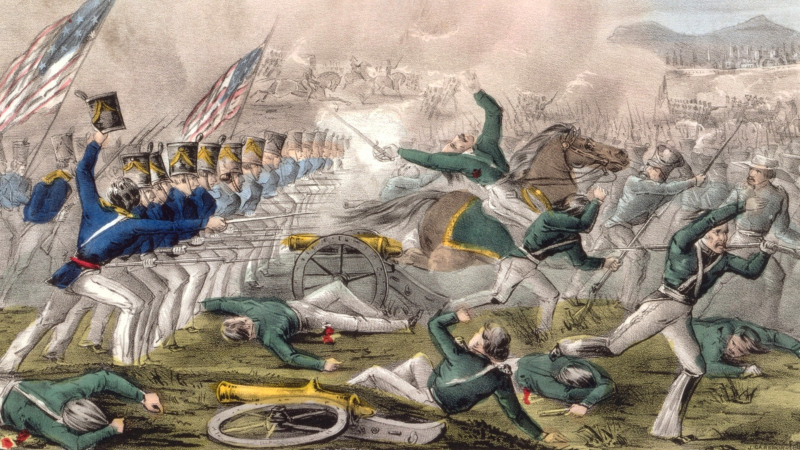
Cadets of US Military Academy joined the Mexico-American War - grunge.com -
Thanks to the roles its graduates played immediately following the Civil War, the institution attained an unheard-of reputation. The Academy, however, had tough times after the Civil War as it attempted to reintegrate and welcome students from the previous coalition nations. In 1868, the first cadets from the Southern states were re-admitted, and James Webster Smith of South Carolina, the first black practitioner, was accepted in 1870. Smith endured harsh treatment before being fired due to a lack of education in 1874. After a long period of rigorous training, George Washington Goethals and John J. Pershing, two of the era's most prominent alums, graduated in 1880 and 1886, respectively. Goethals achieved distinction as the head engineer of the Panama Canal, while Pershing became well-known for his exploits in Mexico against Pancho Villa and then for commanding the American forces in World War I.
In addition to integrating black practitioners and Southern states, bullying was another issue that the post-war Academy faced. For the first 65 years, bullying was not common beyond the small jokes for incoming freshmen, but this got worse when Civil War veterans began filling freshman classes. In particular, after former Academy cadet, Oscar L. Booz passed away on December 3, 1900, hazing at the school gained widespread notice. The circumstances surrounding his death and the regular habit of bullying among freshmen were looked at in congressional hearings, which included testimony from professional Douglas MacArthur. Therefore, after MacArthur took over as superintendent, he made an effort to stop the practice of intimidating incoming freshmen by assigning Army sergeants to oversee the summertime training of new cadets. And this brought positive results because statistically, the number of bullying incidents in the academy decreased significantly after applying his efforts.
To conclude, the Academy had tough times in the years after the Civil War, especially:
- Attempting to reintegrate and welcome students from the previous coalition nations.
- Bullying became acute after former Academy student Oscar L. Booz died as a result of being bullied.
- After MacArthur assumed the position of superintendent, he worked to prevent intimidation among freshmen.
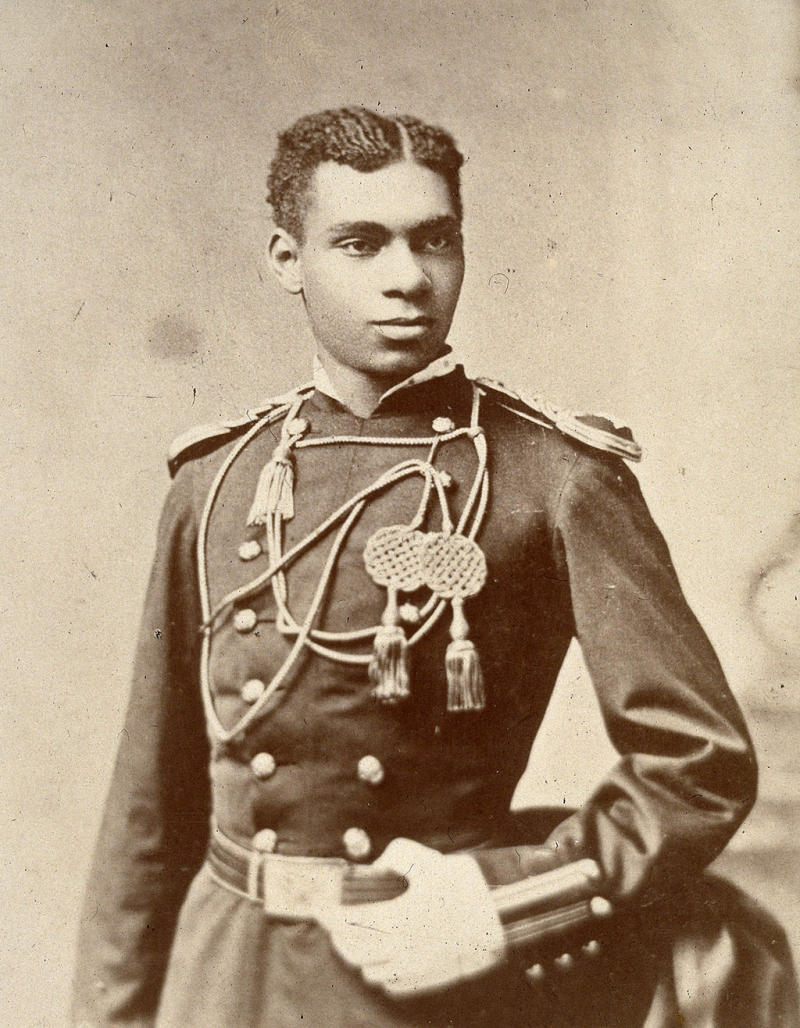
Henry Ossian Flipper who was bullied at the Academy - blackpast.org 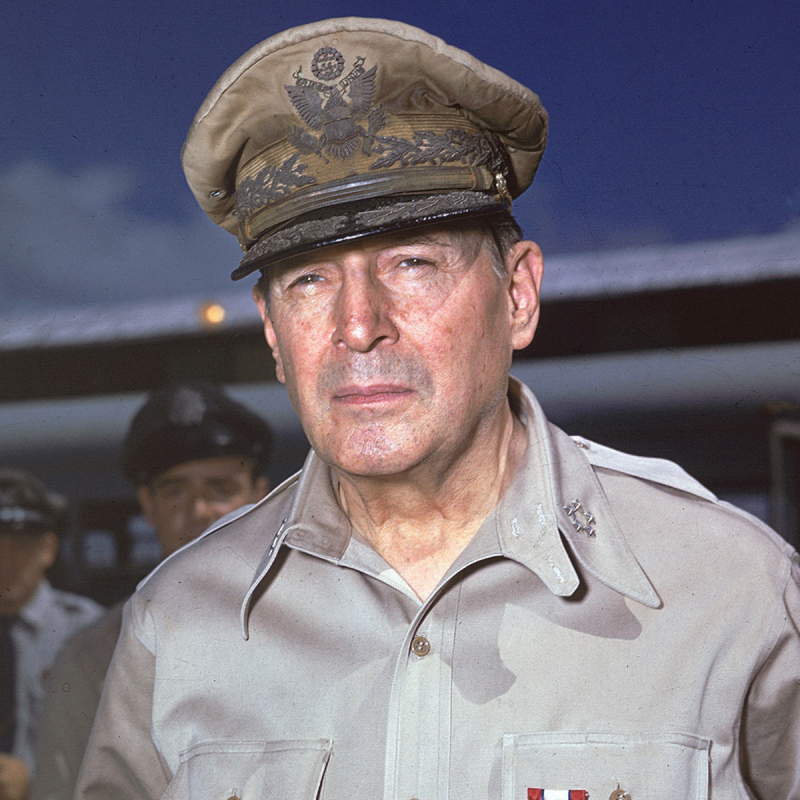
Douglas MacArthur - biography.com -
The Academy's admission requirements are extremely rigorous. With the exception of some cases for 24-year-olds who are in the military and cannot attend before their 24th birthday, applicants must be between 17 and 23 years old, unmarried, and have no legal obligation to support a child. High school and college GPAs must be above average, and they must, at a minimum, perform well on the Academy's standardized tests. The standard interquartile range on the old SAT was between 1100 and 1360, and 68% of students should have ranked in the top 5 of their high school class. In addition, to be eligible to apply, candidates must also undergo the Academy's comprehensive physical exam and fitness assessment.
Some other cases may occur such as applicants who have previous college experience but they also do not have the right to transfer schools. This means that no matter how many college credits they have taken before, they still enter the academy as fourth-rate students and go through the entire four-year program. However, if an applicant is deemed academically ineligible and not selected, he or she may receive an offer of admission to the United States Military Academy Preparatory School. After graduation from USMAPS, these applicants will be assigned to the academy if they receive a recommendation from the USMAPS Commander and meet the physical requirements for admission.
For individuals who are qualified but not chosen, the West Point Graduate Association (WPAOG) offers scholarships as well. For private universities, scholarships generally cover roughly $7,000. The recipients of these scholarships will be allowed to enroll in West Point one year after receiving them. AOG-approved programs include Marion Military Academy, New Mexico Military Academy, Georgia Military College, Hargrave Military Academy, Greystone Preparatory School at Schreiner University, and Northwest Preparatory School, where students enrolled prior to receiving a West Point admissions offer.
In sum, candidates when applying for admission to the US Military Academy must go through a rigorous testing process:
- Ages 17 to 23, unmarried and has no legal obligation to support children.
- Perform well on the Academy's standardized tests, and meet the physical requirements for admission.
- The benchmark on the old SAT was between 1100 and 1360 and 68% of students had to rank in the top 5 of their high school class.
- Entered the academy as a fourth-rate student and completed the entire four-year program regardless of prior college attendance.
- Can attend many other training programs before applying to the Academy.
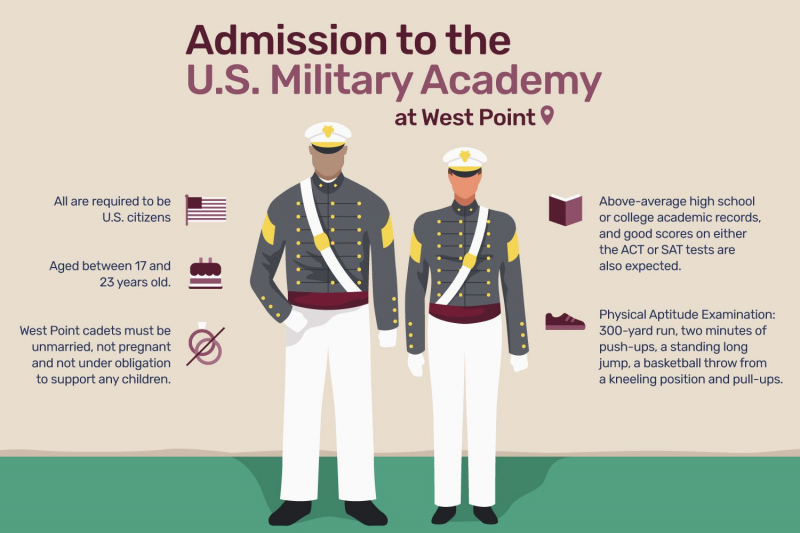
Admission requirement of the Academy - liveabout.com StudyPointVideo -
The Thayer Method, which Sylvanus Thayer embraced during his tenure as Superintendent, is a component of the teaching methodology used at the institution. This strategy establishes small classes with daily assignments to encourage students to take the initiative to take responsibility for their own learning by asking them to do their homework and bring it up for discussion in class.
The academic program consists of a core structure of 31 courses that balance the arts and sciences. The academy runs on what it refers to as a "term" system, with term 1 being the autumn semester and term 2 being the spring semester. Although students choose their major in the spring of their freshman year, they all take the same course until the start of their sophomore year.
This core teaching course covers comprehensive subjects such as mathematics, information technology, chemistry, physics, engineering, history, geography, philosophy, general psychology, English literature, foreign languages, economics, political science, international relations, and constitutional law. Some highly advanced students might be able to confirm dropping out of junior-level coursework and enrolling in advanced or accelerated courses as a freshman or sophomores instead. And regardless of their major, all students graduate with a Bachelor of Science degree.
In short, the Academy applied Thayer's method in the teaching and learning process:
- Small classes with daily assignments by asking them to do their homework and discussion in class.
- Consists of a core structure of 31 courses that balance the arts and sciences with 2 terms.
- Covers subjects such as mathematics, chemistry, physics, engineering, English literature, foreign languages, economics, political science, international relations, and constitutional law.
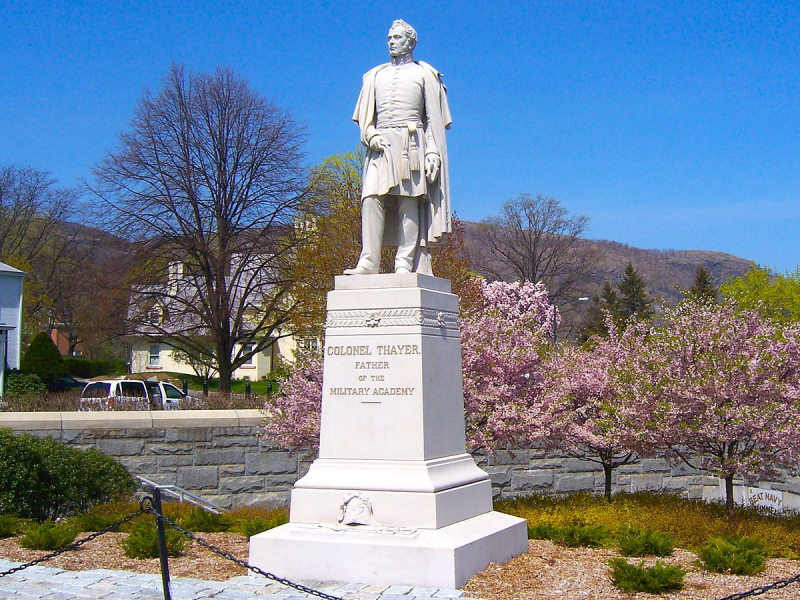
Thayer's statue at West Point - wikimedia.com 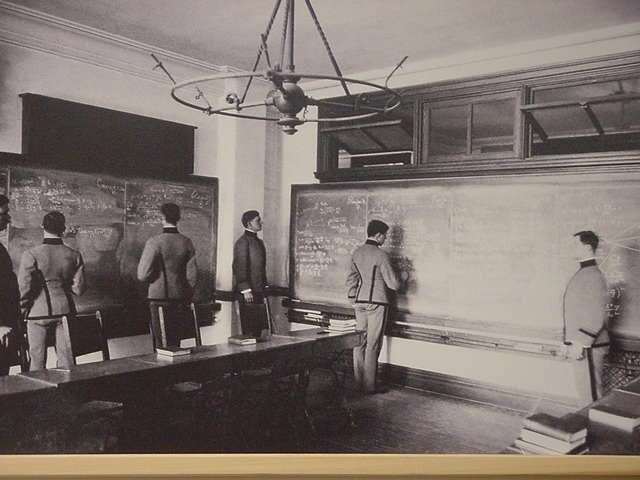
Mathematics education at West Point - maa.org -
By adhering to the honor code and participating in the academy's official leadership programs, cadets strengthen their moral and ethical values during their whole time as members of the military. These include engagement with staff and professors who serve as role models, learning about the ideals of the military profession through Professional Military Ethics Education (PME2), voluntary religious activities, and a robust guest speaker schedule. The motto of West Point, "Duty, Honor, Country" serves as the cornerstone of its ethical code.
According to the West Point Cadet Honor Code, a cadet will not lie, cheat, steal, or tolerate others who do. A hearing and investigation procedure is in store for cadets who are suspected of breaking the honor code. They risk severe repercussions, such as being "turned back" (repeating an academic year) or expulsion from the Academy if they are found guilty by a jury of their peers. Prior to 1973, when it came under intense public criticism, cadets utilized an unofficial punishment known as "silencing" to enforce collective condemnation by refusing to talk to other cadets who were allegedly breaking the honor code.
Despite the fact that the Academy's honor code is highly recognized and has had a considerable impact on many other schools and institutions, there have been a number of serious infractions. For instance, 151 junior cadets were expelled from school in 1976 for "violating the honor code" during tests. More than 70 cadets were also charged with test fraud in 2020.
To conclude, cadets must adhere to moral and ethical values by the code of honor:
- Participating, and learning about the ideals of the military profession, and voluntary religious activities with the motto of West Point, "Duty, Honor, Country".
- Not lying, cheating, stealing, or tolerating people who do so.
- Although the Academy's code of honor is highly regarded, there are still some serious violations.
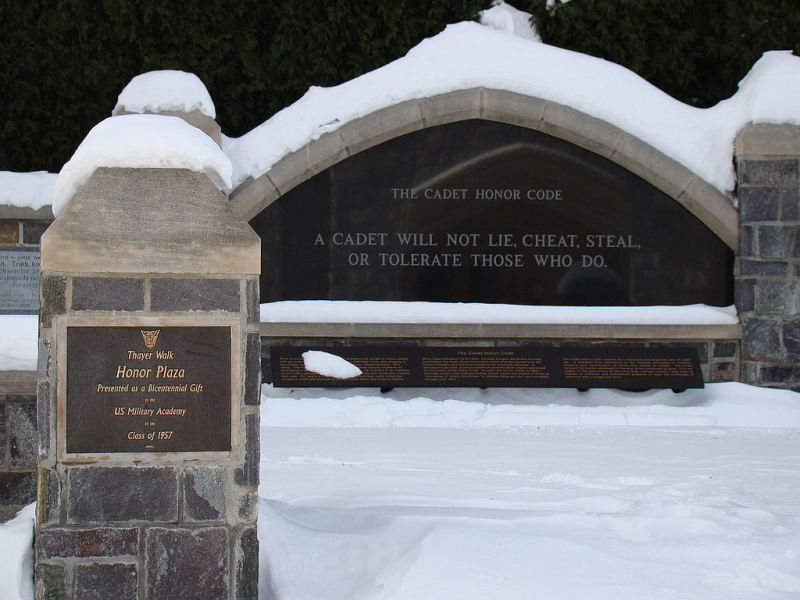
Class of 57 honor memorial on which the honor code is inscribed - wikipedia.org 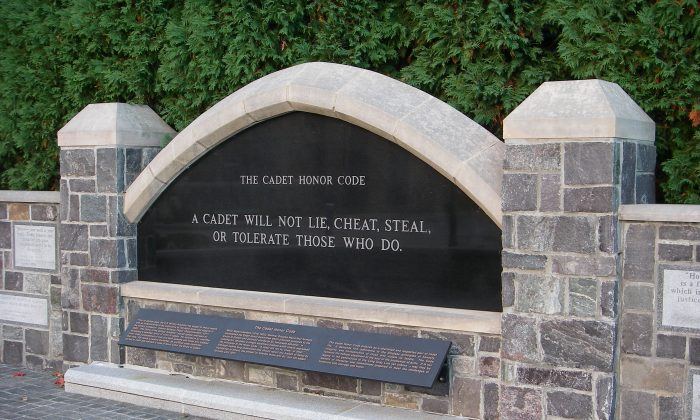
theepochtimes.com -
The terms "freshman," "sophomore," "junior," and "senior" do not apply to cadets. Instead, they are referred to as cadets of the fourth, third, second, and first classes, respectively. Freshmen are known as plebes, sophomores as yearlings or yuks, juniors as cows, and seniors as firsties in common parlance.
Some class names have well-known etymologies, while others do not. In particular, Plebeians were at the lesser level in classical Roman society, and yearling is a euphemism for an animal that is a year old. Besides, few people are aware of the cow's origin. There are other explanations about the origin of the name "cow," but the most popular and possibly correct one is that in the past, cadets were not allowed to take a break until the conclusion of their yearling year, at which point they were given a summer-long furlough. Thus, "the cows coming home" was used to describe their return as second-class cadets.
The Corps of Cadets is formally organized into a brigade. First Captain has historically been the title given to the cadet with the highest rank, the Brigade Commander. The brigade is organized into four regiments. Each regiment consists of three battalions, each with three companies. Companies are identified by the letters A through I, and a number designates the regiment to which they belong. For instance, the letter "H" stands for four different companies: H1, H2, H3, and H4. The brigade's leadership, from the First Captain down to the platoon leaders within the companies, is comprised of first-class cadets. Second-class cadets carry the rank of cadet sergeant, third-class cadets hold the rank of cadet corporal, and fourth-class cadets are cadet privates, assuming less responsibility for leadership.
In sum, the terms "freshman," "sophomore," "junior," and "senior" do not apply to cadets in US Military Academy at West Point:
- They are referred to as cadets of the fourth, third, second, and first classes, respectively.
- Freshmen are known as plebes, sophomores as yearlings or yuks, juniors as cows, and seniors as firsties.
- The Corps of Cadets is organized into a brigade that includes four regiments. Each regiment consists of three battalions, each with three companies.
- The brigade leadership, from the company captain to the platoon commanders, consisted of first-class cadets.
- Second-class cadets with the rank of sergeant, third-class students with the rank of corporal, and fourth-rate students are private.
Rank Structure of West Point - WarBondz 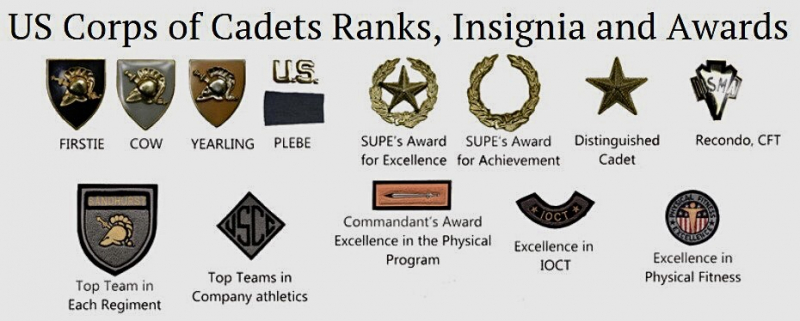
Cadet Rank, Insignia, and Awards - westpoint.edu -
Cadets are admitted from all 50 states, Puerto Rico, the District of Columbia, the Mariana Islands, Guam, American Samoa, and the U.S. Virgin Islands according to the academy's congressional nomination procedure. The Academy is also permitted to accept 60 cadets from other countries on the exchange, who follow the same four-year program as fully integrated Practitioner Corps members.
At the United States Military Academy, the cadets get free education. In exchange for a promise to service for 5 years in the army and 3 years in reserve status after graduation, the Army will pay all of your living expenses and tuition for cadets. Those trainees who do not graduate after the first day of their second year of studies shall serve out their military duty. Since 2015, students have been given a $1,017.00 monthly stipend to use for books, uniforms, and other essentials. However, from this amount, wages are automatically deducted for other expenses such as books, uniforms, supplies, services, meals, and other miscellaneous expenses. Each student is free to spend whatever money is left over after deductions. Besides, all cadets eat in the cafeteria and have access to the internet on devices that have been authorized and licensed.
In short, the United State Military Academy:
- accepts students from all 50 states and 60 students from other countries.
- pays all costs for cadets during 4 years of study in exchange for the promise of 5 years of service in the military and 3 years in reserve status after graduation.
- Since 2015, cadets have been given $1,017.00 monthly to purchase books, uniforms, and other necessities.
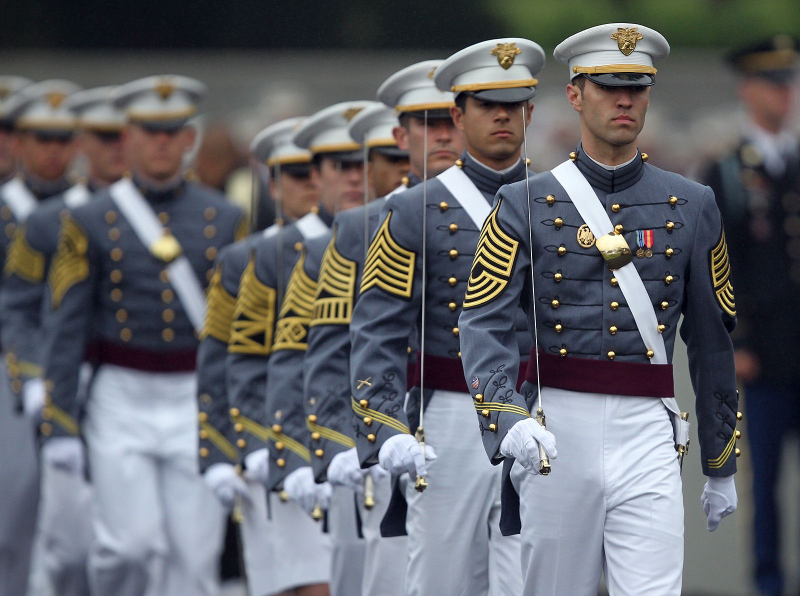
The uniform of cadets at the West Point - reddit.com -
Academy cadets engage in a variety of extracurricular activities, the majority of which are managed by the Directorate General of Student Activities office (DCA). 113 sports and non-sports clubs are sponsored and run by DCA. Throughout their stay at the school, many students join a variety of groups and find that their club time provides a much-needed break from the rigors of student life. DCA is also in charge of a number of initiatives that enhance the quality of life for its students, including three student eateries including the Cadet Store, Howitzer, and Bugle Notes.
The Bugle Notes, commonly referred to as the "plebe bible," is the handbook of plebe knowledge, whereas the Howitzer is the annual yearbook. All plebes are required to learn a vast amount of plebe knowledge throughout cadet basic training, which consists of customs, songs, poetry, tales, and information about the school, the army, the Old Corps, and the rivalry with the Navy. Plebes are supposed to respond to any questions regarding their subject matter that cadets from higher classes may pose to them during their first year. These pieces of knowledge are of a historical nature that cadets can find information in Bugle Notes. However, there is also some knowledge that changes daily, such as "days" (a continuous list of days until important academy events), the canteen's menu of the day, or even stories in the New York Times.
Every academic year, there is at least one "class weekend" celebration for each cadet class. Plebe Parent Weekend is held the first weekend of spring vacation and is attended by fourth-class cadets. Yearling Winter Weekend is a celebration of the winter season for third-class cadets held in February. The second-class cadets commemorate the final 500 days before graduation with 500th Night in late January while first-class cadets celebrate three official events. They enjoy Ring Weekend in late August, 100th Night in February to celebrate their last 100 days, and a full week of activities in May that ends with graduation. Every one of the "class weekends" includes a formal supper and a social dance in Eisenhower Hall called a "hop," in the language of the old cadets.
To conclude, cadets have a host of extracurricular activities available at West Point:
- 113 sports and non-sports clubs are sponsored and operated by the Directorate of Student Activities (DCA).
- 3 cafeterias that improve the quality of life for students include Cadet Store, Howitzer, and Bugle Notes.
- every academic year, there is at least one "class weekend" celebration for each cadet class.
- Plebe Parent Weekend for fourth-class cadets.
- Yearling Winter Weekend for third-class cadets in February.
- The second-class cadets commemorate the final 500 days before graduation in late January.
- The first-class cadets celebrate three official events: Ring Weekend in late August, 100th Night in February, and a full week of activities in May.
USMA Plebe Parent Weekend Parade Class of 2022 - Grant E. McCosh West Point 2022 Ring Ceremony - West Point-The US Military Academy -
The Academy also has a wide variety of sports programs. Approximately 15% of the Academy's students are members of club sports teams. There are 24 club sports teams at West Point, and they have all had great success in recent years, taking home national titles in sports including judo, boxing, orienteering, pistol, triathlon, crew, cycling, and team handball.
Around 65% of cadets participate in intramural sports, sometimes referred to as "corporate athletics". The club's athletics programs are managed by the DPE Competitive Sports Committee, which was recently recognized by the International Institute of Sports as one of the 15 Most Influential Sports Education Teams in the United States.
We can watch basketball, flag football, team handball, soccer, the discus final, and wrestling competitions in the fall at the Academy. While orienteering, strobe ball, floor hockey, and swimming were all competitive events during the spring season. Each company also fields a team to compete in the annual Sandhurst Competition, a military skills competition conducted by Military Command, in the spring.
In sum, West Point has a long history of athletics in other NCAA sports with a wide variety of sports programs:
- 15% of the Academy's students are members of club sports teams.
- About 65% of cadets participate in intramural sports, sometimes referred to as "corporate athletics".
- We can see many athletic competitions at the Academy in the spring and fall.
Army West Point Athletics Sandhurst Military Skills Competition 2022 - West Point - the US Military Academy

















